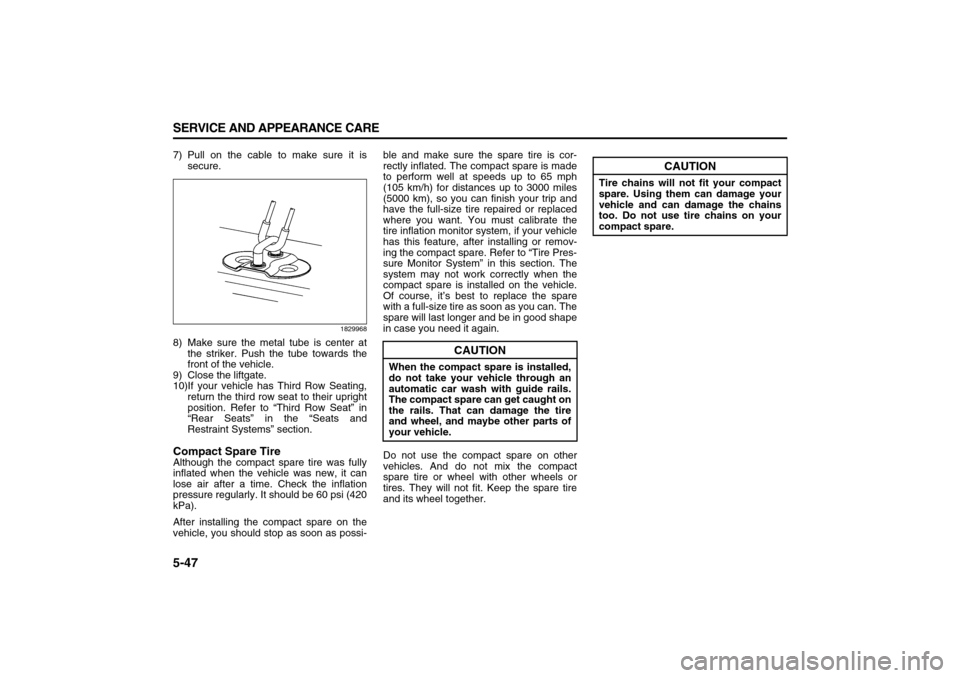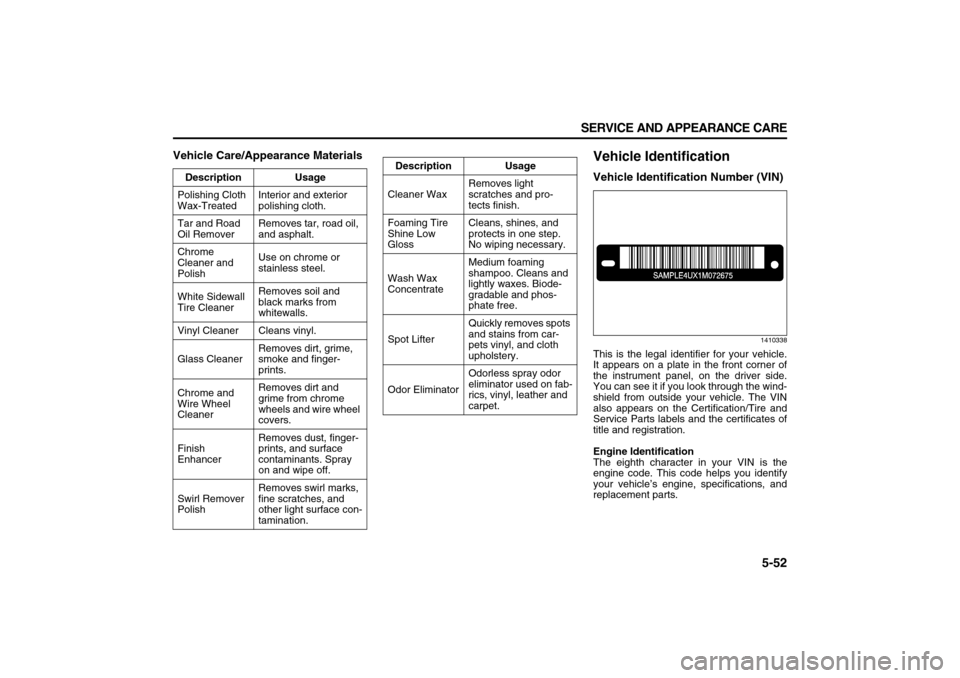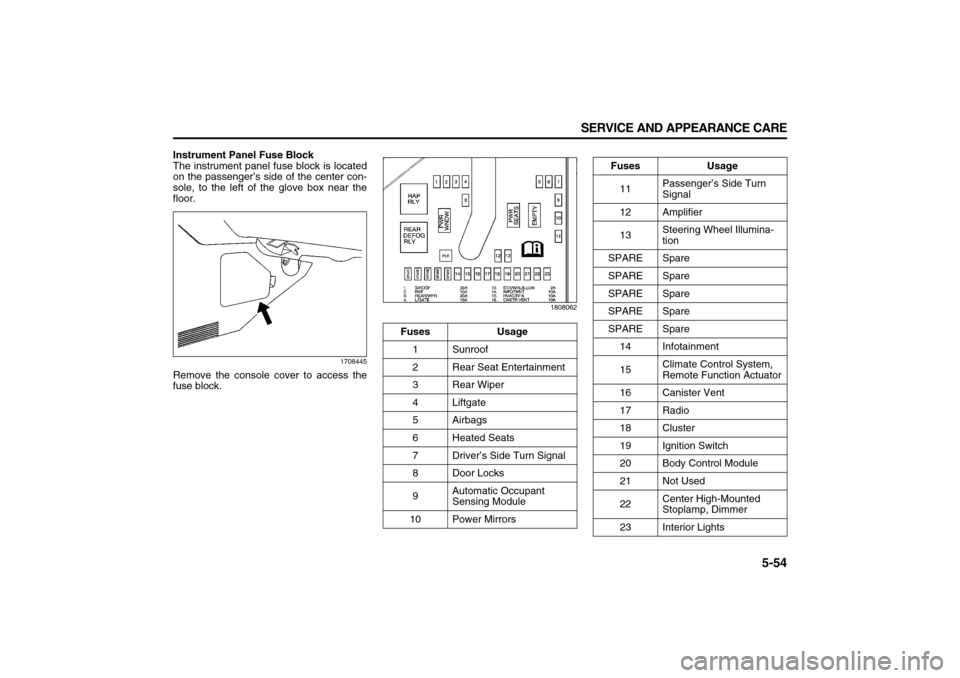SUZUKI XL7 2007 2.G Owners Manual
Manufacturer: SUZUKI, Model Year: 2007, Model line: XL7, Model: SUZUKI XL7 2007 2.GPages: 274, PDF Size: 6.12 MB
Page 231 of 274

5-47 SERVICE AND APPEARANCE CARE
78J00-03E
7) Pull on the cable to make sure it is
secure.
1829968
8) Make sure the metal tube is center at
the striker. Push the tube towards the
front of the vehicle.
9) Close the liftgate.
10)If your vehicle has Third Row Seating,
return the third row seat to their upright
position. Refer to “Third Row Seat” in
“Rear Seats” in the “Seats and
Restraint Systems” section.Compact Spare TireAlthough the compact spare tire was fully
inflated when the vehicle was new, it can
lose air after a time. Check the inflation
pressure regularly. It should be 60 psi (420
kPa).
After installing the compact spare on the
vehicle, you should stop as soon as possi-ble and make sure the spare tire is cor-
rectly inflated. The compact spare is made
to perform well at speeds up to 65 mph
(105 km/h) for distances up to 3000 miles
(5000 km), so you can finish your trip and
have the full-size tire repaired or replaced
where you want. You must calibrate the
tire inflation monitor system, if your vehicle
has this feature, after installing or remov-
ing the compact spare. Refer to “Tire Pres-
sure Monitor System” in this section. The
system may not work correctly when the
compact spare is installed on the vehicle.
Of course, it’s best to replace the spare
with a full-size tire as soon as you can. The
spare will last longer and be in good shape
in case you need it again.
Do not use the compact spare on other
vehicles. And do not mix the compact
spare tire or wheel with other wheels or
tires. They will not fit. Keep the spare tire
and its wheel together.
CAUTION
When the compact spare is installed,
do not take your vehicle through an
automatic car wash with guide rails.
The compact spare can get caught on
the rails. That can damage the tire
and wheel, and maybe other parts of
your vehicle.
CAUTION
Tire chains will not fit your compact
spare. Using them can damage your
vehicle and can damage the chains
too. Do not use tire chains on your
compact spare.
Page 232 of 274

5-48 SERVICE AND APPEARANCE CARE
78J00-03E
Appearance CareCleaning the Inside of Your VehicleYour vehicle’s interior will continue to look
its best if it is cleaned often. Although not
always visible, dust and dirt can accumu-
late on your upholstery. Dirt can damage
carpet, fabric, leather, and plastic sur-
faces. Regular vacuuming is recom-
mended to remove particles from your
upholstery. It is important to keep your
upholstery from becoming and remaining
heavily soiled. Soils should be removed as
quickly as possible. Your vehicle’s interior
may experience extremes of heat that
could cause stains to set rapidly.
Lighter colored interiors may require more
frequent cleaning. Use care because
newspapers and garments that transfer
color to your home furnishings may also
transfer color to your vehicle’s interior.
When cleaning your vehicle’s interior, only
use cleaners specifically designed for the
surfaces being cleaned. Permanent dam-
age may result from using cleaners on sur-
faces for which they were not intended.
Use glass cleaner only on glass. Remove
any accidental over-spray from other sur-
faces immediately. To prevent over-spray,
apply cleaner directly to the cleaning cloth.Many cleaners contain solvents that may
become concentrated in your vehicle’s
breathing space. Before using cleaners,
read and adhere to all safety instructions
on the label. While cleaning your vehicle’s
interior, maintain adequate ventilation by
opening your vehicle’s doors and windows.
Dust may be removed from small buttons
and knobs using a small brush with soft
bristles.
Your SUZUKI dealer has a product for
cleaning your vehicle’s glass. Should it
become necessary, you can also obtain a
product from your SUZUKI dealer to
remove odors from your vehicle’s uphol-
stery.
Do not clean your vehicle using the follow-
ing cleaners or techniques:
Never use a knife or any other sharp
object to remove a soil from any interior
surface. Never use a stiff brush. It can cause
damage to your vehicle’s interior sur-
faces.
Never apply heavy pressure or rub
aggressively with a cleaning cloth. Use
of heavy pressure can damage your
interior and does not improve the effec-
tiveness of soil removal.
Use only mild, neutral-pH soaps. Avoid
laundry detergents or dishwashing
soaps with degreasers. Using too much
soap will leave a residue that leaves
streaks and attracts dirt. For liquid clean-
ers, about 20 drops per gallon (3.78 L) of
water is a good guide.
Do not heavily saturate your upholstery
while cleaning.
Damage to your vehicle’s interior may
result from the use of many organic sol-
vents such as naptha, alcohol, etc.
Fabric/CarpetUse a vacuum cleaner with a soft brush
attachment frequently to remove dust and
loose dirt. A canister vacuum with a beater
bar in the nozzle may only be used on floor
carpet and carpeted floor mats. For soils,
always try to remove them first with plain
water or club soda. Before cleaning, gently
remove as much of the soil as possible
using one of the following techniques:
For liquids: gently blot the remaining soil
with a paper towel. Allow the soil to
absorb into the paper towel until no more
can be removed.
CAUTION
If you use abrasive cleaners when
cleaning glass surfaces on your vehi-
cle, you could scratch the glass and/
or cause damage to the rear window
defogger. When cleaning the glass
on your vehicle, use only a soft cloth
and glass cleaner.
Page 233 of 274

5-49 SERVICE AND APPEARANCE CARE
78J00-03E
For solid dry soils: remove as much as
possible and then vacuum.
To clean, use the following instructions:
1) Saturate a lint-free, clean white cloth
with water or club soda.
2) Wring the cloth to remove excess mois-
ture.
3) Start on the outside edge of the soil and
gently rub toward the center. Continue
cleaning, using a clean area of the cloth
each time it becomes soiled.
4) Continue to gently rub the soiled area
until the cleaning cloth remains clean.
5) If the soil is not completely removed,
use a mild soap solution and repeat the
cleaning process that was used with
plain water.
If any of the soil remains, a commercial
fabric cleaner or spot lifter may be neces-
sary. When a commercial upholstery
cleaner or spot lifter is to be used, test a
small hidden area for colorfastness first. If
the locally cleaned area gives any impres-
sion that a ring formation may result, clean
the entire surface.
After the cleaning process has been com-
pleted, a paper towel can be used to blot
excess moisture from the fabric or carpet.LeatherA soft cloth dampened with water may be
used to remove dust. If a more thorough
cleaning is necessary, a soft cloth damp-ened with a mild soap solution can be
used. Allow the leather to dry naturally. Do
not use heat to dry. Never use steam to
clean leather. Never use spot lifters or spot
removers on leather. Many commercial
leather cleaners and coatings that are sold
to preserve and protect leather may per-
manently change the appearance and feel
of your leather and are not recommended.
Do not use silicone or wax-based prod-
ucts, or those containing organic solvents
to clean your vehicle’s interior because
they can alter the appearance by increas-
ing the gloss in a non-uniform manner.
Never use shoe polish on your leather.
Instrument Panel, Vinyl, and Other
Plastic SurfacesA soft cloth dampened with water may be
used to remove dust. If a more thorough
cleaning is necessary, a clean soft cloth
dampened with a mild soap solution can
be used to gently remove dust and dirt.
Never use spot lifters or removers on plas-
tic surfaces. Many commercial cleaners
and coatings that are sold to preserve and
protect soft plastic surfaces may perma-
nently change the appearance and feel of
your interior and are not recommended.
Do not use silicone or wax-based prod-
ucts, or those containing organic solvents
to clean your vehicle’s interior because
they can alter the appearance by increas-
ing the gloss in a non-uniform manner.Some commercial products may increase
gloss on your instrument panel. The
increase in gloss may cause annoying
reflections in the windshield and even
make it difficult to see through the wind-
shield under certain conditions.
Care of Safety BeltsKeep belts clean and dry.WeatherstripsSilicone grease on weatherstrips will make
them last longer, seal better, and not stick
or squeak. Apply silicone grease with a
clean cloth. During very cold, damp
weather frequent application may be
required. Refer to “Recommended Fluids
and Lubricants” in “Maintenance Sched-
ule” in the “Maintenance Schedule” sec-
tion.Washing Your VehicleThe paint finish on the vehicle provides
beauty, depth of color, gloss retention, and
durability.
WARNING
Do not bleach or dye safety belts. If
you do, it may severely weaken them.
In a crash, they might not be able to
provide adequate protection. Clean
safety belts only with mild soap and
lukewarm water.
Page 234 of 274

5-50 SERVICE AND APPEARANCE CARE
78J00-03E
The best way to preserve the vehicle’s fin-
ish is to keep it clean by washing it often
with lukewarm or cold water.
Do not wash the vehicle in the direct rays
of the sun. Use a car washing soap. Do not
use strong soaps or chemical detergents.
Be sure to rinse the vehicle well, removing
all soap residue completely. Approved
cleaning products can be obtained from
your dealer. Refer to “Vehicle Care/
Appearance Materials” in this section. Do
not use cleaning agents that are petroleum
based, or that contain acid or abrasives.
All cleaning agents should be flushed
promptly and not allowed to dry on the sur-
face, or they could stain. Dry the finish with
a soft, clean chamois or an all-cotton towel
to avoid surface scratches and water spot-
ting.
High pressure car washes may cause
water to enter the vehicle.Cleaning Exterior Lamps/LensesUse only lukewarm or cold water, a soft
cloth and a car washing soap to clean
exterior lamps and lenses. Follow instruc-
tions under “Washing Your Vehicle” in this
section.Finish CareOccasional waxing or mild polishing of the
vehicle by hand may be necessary to
remove residue from the paint finish.
Approved cleaning products can be
obtained from your dealer. Refer to “Vehi-cle Care/Appearance Materials” in this
section.
The vehicle has a basecoat/clearcoat paint
finish. The clearcoat gives more depth and
gloss to the colored basecoat. Always use
waxes and polishes that are non-abrasive
and made for a basecoat/clearcoat paint
finish.
Foreign materials such as calcium chloride
and other salts, ice melting agents, road oil
and tar, tree sap, bird droppings, chemi-
cals from industrial chimneys, etc., can
damage the vehicle’s finish if they remain
on painted surfaces. Wash the vehicle as
soon as possible. If necessary, use non-
abrasive cleaners that are marked safe for
painted surfaces to remove foreign matter.
Exterior painted surfaces are subject to
aging, weather, and chemical fallout that
can take their toll over a period of years.
To help keep the paint finish looking new,
keep the vehicle in a garage or covered
whenever possible.
Windshield and Wiper BladesIf the windshield is not clear after using the
windshield washer, or if the wiper blade
chatters when running, wax, sap, or other
material may be on the blade or wind-
shield.
Clean the outside of the windshield with a
glass cleaning liquid or powder and water
solution. The windshield is clean if beads
do not form when it is rinsed with water.
Grime from the windshield will stick to the
wiper blades and affect their performance.
Clean the blade by wiping vigorously with
a cloth soaked in full-strength windshield
washer solvent. Then rinse the blade with
water.
Check the wiper blades and clean them as
necessary; replace blades that look worn.Aluminum WheelsKeep the wheels clean using a soft clean
cloth with mild soap and water. Rinse with
CAUTION
Machine compounding or aggres-
sive polishing on a basecoat/
clearcoat paint finish may damage it.
Use only non-abrasive waxes and
polishes that are made for a
basecoat/clearcoat paint finish on
your vehicle.
CAUTION
If you use strong soaps, chemicals,
abrasive polishes, cleaners, brushes,
or cleaners that contain acid on alu-
minum or chrome-plated wheels, you
could damage the surface of the
wheel(s). The repairs would not be
covered by your warranty. Use only
SUZUKI-approved cleaners on alumi-
num or chrome-plated wheels.
Page 235 of 274

5-51 SERVICE AND APPEARANCE CARE
78J00-03E
clean water. After rinsing thoroughly, dry
with a soft clean towel. A wax may then be
applied.
The surface of these wheels is similar to
the painted surface of the vehicle. Do not
use strong soaps, chemicals, abrasive pol-
ishes, abrasive cleaners, cleaners with
acid, or abrasive cleaning brushes on them
because the surface could be damaged.
Do not use chrome polish on aluminum
wheels.Do not take the vehicle through an auto-
matic car wash that has silicone carbide
tire cleaning brushes. These brushes can
also damage the surface of these wheels.
TiresTo clean the tires, use a stiff brush with tire
cleaner.Sheet Metal DamageIf the vehicle is damaged and requires
sheet metal repair or replacement, make
sure the body repair shop applies anti-cor-
rosion material to parts repaired or
replaced to restore corrosion protection.
Original manufacturer replacement parts
will provide the corrosion protection while
maintaining the warranty.Finish DamageAny stone chips, fractures or deep
scratches in the finish should be repaired
right away. Bare metal will corrode quickly
and may develop into major repair
expense.
Minor chips and scratches can be repaired
with touch-up materials available from yourSUZUKI dealer. Larger areas of finish
damage can be corrected in your SUZUKI
dealer’s body and paint shop.
Underbody MaintenanceChemicals used for ice and snow removal
and dust control can collect on the under-
body. If these are not removed, corrosion
and rust can develop on the underbody
parts such as fuel lines, frame, floor pan,
and exhaust system even though they
have corrosion protection.
At least every spring, flush these materials
from the underbody with plain water. Clean
any areas where mud and debris can col-
lect. Dirt packed in close areas of the
frame should be loosened before being
flushed. Your dealer or an underbody car
washing system can do this for you.Chemical Paint SpottingSome weather and atmospheric conditions
can create a chemical fallout. Airborne pol-
lutants can fall upon and attack painted
surfaces on the vehicle. This damage can
take two forms: blotchy, ring-shaped dis-
colorations, and small, irregular dark spots
etched into the paint surface.
Although no defect in the paint job causes
this, SUZUKI will repair, at no charge to
the owner, the surfaces of new vehicles
damaged by this fallout condition within 12
months or 12000 miles (20000 km) of pur-
chase, whichever occurs first.
CAUTION
Using chrome polish on aluminum
wheels could damage the wheels.
The repairs would not be covered by
your warranty. Use chrome polish on
chrome wheels only.
CAUTION
If you drive your vehicle through an
automatic car wash that has silicone
carbide tire cleaning brushes, you
could damage the aluminum or
chrome-plated wheels. The repairs
would not be covered by your war-
ranty. Never drive a vehicle equipped
with aluminum or chrome-plated
wheels through an automatic car
wash that uses silicone carbide tire
cleaning brushes.
CAUTION
Using petroleum-based tire dressing
products on your vehicle may dam-
age the paint finish and/or tires.
When applying a tire dressing,
always wipe off any overspray from
all painted surfaces on your vehicle.
Page 236 of 274

5-52 SERVICE AND APPEARANCE CARE
78J00-03E
Vehicle Care/Appearance Materials
Vehicle IdentificationVehicle Identification Number (VIN)
1410338
This is the legal identifier for your vehicle.
It appears on a plate in the front corner of
the instrument panel, on the driver side.
You can see it if you look through the wind-
shield from outside your vehicle. The VIN
also appears on the Certification/Tire and
Service Parts labels and the certificates of
title and registration.
Engine Identification
The eighth character in your VIN is the
engine code. This code helps you identify
your vehicle’s engine, specifications, and
replacement parts. Description Usage
Polishing Cloth
Wax-TreatedInterior and exterior
polishing cloth.
Tar and Road
Oil RemoverRemoves tar, road oil,
and asphalt.
Chrome
Cleaner and
PolishUse on chrome or
stainless steel.
White Sidewall
Tire CleanerRemoves soil and
black marks from
whitewalls.
Vinyl Cleaner Cleans vinyl.
Glass CleanerRemoves dirt, grime,
smoke and finger-
prints.
Chrome and
Wire Wheel
CleanerRemoves dirt and
grime from chrome
wheels and wire wheel
covers.
Finish
EnhancerRemoves dust, finger-
prints, and surface
contaminants. Spray
on and wipe off.
Swirl Remover
PolishRemoves swirl marks,
fine scratches, and
other light surface con-
tamination.
Description Usage
Cleaner WaxRemoves light
scratches and pro-
tects finish.
Foaming Tire
Shine Low
GlossCleans, shines, and
protects in one step.
No wiping necessary.
Wash Wax
ConcentrateMedium foaming
shampoo. Cleans and
lightly waxes. Biode-
gradable and phos-
phate free.
Spot LifterQuickly removes spots
and stains from car-
pets vinyl, and cloth
upholstery.
Odor EliminatorOdorless spray odor
eliminator used on fab-
rics, vinyl, leather and
carpet.
Page 237 of 274

5-53 SERVICE AND APPEARANCE CARE
78J00-03E
Service Parts Identification LabelThis label is on the inside of the glove box.
It is very helpful if you ever need to order
parts. The label has the following informa-
tion:
Vehicle Identification Number (VIN)
Model designation
Paint information
Production options and special equip-
ment
Do not remove this label from the vehicle.
Electrical SystemAdd-On Electrical EquipmentAdd-on equipment can drain your vehicle’s
battery, even if your vehicle is not operat-
ing.
Your vehicle has an airbag system. Before
attempting to add anything electrical to
your vehicle, refer to “Servicing Your Air-
bag-Equipped Vehicle” in “Airbag System”
in the “Seats and Restraint Systems” sec-
tion.Windshield Wiper FusesThe windshield wiper motor is protected by
a circuit breaker and a fuse. If the motor
overheats due to heavy snow or ice, the
wiper will stop until the motor cools. If the
overload is caused by some electrical
problem, have it fixed.
Power Windows and Other Power
OptionsCircuit breakers in the fuse panel protect
the power seats. When the current load is
too heavy, the circuit breaker opens and
closes, protecting the circuit until the prob-
lem is fixed.Fuses and Circuit BreakersThe wiring circuits in your vehicle are pro-
tected from short circuits by fuses and cir-
cuit breakers. This greatly reduces the
chance of circuit overload and fire caused
by electrical problems.
Your vehicle has an underhood fuse block
and an instrument panel fuse block.
To identify and check fuses, circuit break-
ers, and relays, refer to the Fuse Usage
Chart on the inside surface of the fuse
panel door.
CAUTION
Do not add anything electrical to your
vehicle unless you check with your
dealer first. Some electrical equip-
ment can damage your vehicle and
the damage would not be covered by
your warranty. Some add-on electri-
cal equipment can keep other compo-
nents from working as they should.
Page 238 of 274

5-54 SERVICE AND APPEARANCE CARE
78J00-03E
Instrument Panel Fuse Block
The instrument panel fuse block is located
on the passenger’s side of the center con-
sole, to the left of the glove box near the
floor.
1708445
Remove the console cover to access the
fuse block.
1808062
Fuses Usage
1 Sunroof
2 Rear Seat Entertainment
3 Rear Wiper
4 Liftgate
5 Airbags
6 Heated Seats
7 Driver’s Side Turn Signal
8 Door Locks
9Automatic Occupant
Sensing Module
10 Power Mirrors
Fuses Usage
11Passenger’s Side Turn
Signal
12 Amplifier
13Steering Wheel Illumina-
tion
SPARE Spare
SPARE Spare
SPARE Spare
SPARE Spare
SPARE Spare
14 Infotainment
15Climate Control System,
Remote Function Actuator
16 Canister Vent
17 Radio
18 Cluster
19 Ignition Switch
20 Body Control Module
21 Not Used
22Center High-Mounted
Stoplamp, Dimmer
23 Interior Lights
Page 239 of 274

5-55 SERVICE AND APPEARANCE CARE
78J00-03E
Engine Compartment Fuse Block
1739443
The engine compartment fuse block is
located on the driver’s side of the engine
compartment.
Refer to “Engine Compartment Overview”
in this section for more information on loca-
tion. Relays Usage
RAP RLYRetained Accessory
Power Relay
REAR
DEFOG
RLYRear Defogger Relay
Circuit
BreakersUsage
PWR
WNDWPower Windows
PWR
SEATSPower Seats
EMPTY Empty
Misc. Usage
PLR Fuse Puller
Fuses Usage
1 Cooling Fan 2
2 Cooling Fan 1
3 Auxiliary Power
4 Rear Climate Control
5 Spare
6 Spare
7 Anti-lock Brake System
8 Air Conditioning Clutch
9 Driver’s Side Low-Beam
10 Daytime Running Lamp 2
11Passenger’s Side High-
Beam
12Passenger’s Side Park
Lamp
13 Horn
14 Driver’s Side Park Lamp
15 Starter
16Electronic Throttle Con-
trol, Engine Control Mod-
ule
17 Emission Device 1
Page 240 of 274

5-56 SERVICE AND APPEARANCE CARE
78J00-03E
Fuses Usage
18 Even Coils, Injectors
19 Odd Coils, Injectors
20 Emission Device 2
21 Spare
22Powertrain Control Mod-
ule, Ignition
23 Transmission
24 Mass Airflow Sensor
25 Airbag Display
26 Spare
27 Stoplamp
28Passenger’s Side Low-
Beam
29 Driver’s Side High-Beam
30 Battery Main 3
32 Spare
33Engine Control Module,
Battery
34Transmission Control
Module, Battery
35 Trailer Park Lamp
36 Front Wiper
Fuses Usage
37Driver’s Side Trailer
Stoplamp, Turn Signal
38 Spare
39 Fuel Pump
40Rear Accessory Power
Outlet
41 All-Wheel Drive
42 Regulated Voltage Control
43Passenger’s Side Trailer
Stoplamp, Turn Signal
44 Spare
45 Front, Rear Washer
48 Rear Defogger
49Anti-lock Brake System
Motor
50 Battery Main 2
52 Daytime Running Lamps
53 Fog Lamps
54Climate Control System
Blower
57 Battery Main 1
63 Electric Power Steering
Relays Usage
31 Ignition Main
46Air Conditioning Compres-
sor Clutch
47 Powertrain
51 Spare
55 Crank
56 Fan 1
58Passenger’s Side Trailer
Stoplamp, Turn Signal
59Driver’s Side Trailer
Stoplamp, Turn Signal
60 Fan 3
61 Fan 2
62 Fuel Pump